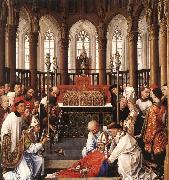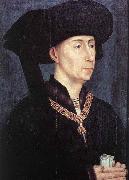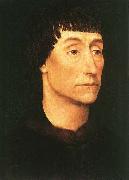All WEYDEN, Rogier van der Oil PaintingsNetherlandish Northern Renaissance Painter, ca.1400-1464 |
|||
 |
|||
|
|
|
||||||||||
|
|
||||||||||
|
Exhumation of St Hubert Pintura identificación:: 52208 |
Exhumation of St Hubert 1437-40 Oil on oak |
|||||||||
|
|
||||||||||
|
|
Lady Wearing a Gauze Headdress Pintura identificación:: 63849 |
Lady Wearing a Gauze Headdress 1445 Oil on oak panel, 47 x 32 cm Staatliche Museen, Berlin Leaving aside the portraits of the Duke and Duchess of Burgundy (Philip the Good and Isabella of Portugal), which have been preserved only in copies (by anonymous masters, now in Berlin and Malibu), the only extant panel portrait from the period before about 1450 is the Portrait of a Young Woman. The young woman, with her expansive Flemish winged or horned coif of fine linen, through which the forehead remains visible, fills almost the entire panel. The 'nakedness' of the face and the softness of the features form an attractive contrast to the firm outlines of the stiffly folded linen and the dark background. The sitter's hands with beringed fingers are laid firmly on one another and rest on an invisible sill, support being provided visually by the frame. While in his twenties the artist married Elisabeth Goffaerts, a native of Brussels, and it has been generally assumed that she is the subject of the Berlin portrait. Although there is no real foundation for it, this is not an unreasonable assumption; the open, warmhearted expression seems to preclude an official portrait and to suggest someone close to the artist. It was undoubtedly this impression of intimacy created in this portrait - it occurs nowhere else in the painter's work - which seemed to call for some explanation. To portray the subject looking directly at the viewer was something quite new when this painting was executed; in the Netherlands this technique occurs for the first time in van Eyck's portraits. The resemblance to the portrait of a woman by the Master of Fl?malle (now in the National Gallery, London) is worth noting. The artist has modelled his subject with sympathy and sensitivity, while avoiding contact with the observer.Artist:WEYDEN, Rogier van der Title: Lady Wearing a Gauze Headdress Painted in 1401-1450 , Flemish - - painting : portrait |
||||||||
|
|
||||||||||
|
|
Portrait of Philip the Good after Pintura identificación:: 63854 |
Portrait of Philip the Good after 1450 Oil on wood, 31 x 23 cm Kunsthistorisches Museum, Vienna The Duchy of Burgundy had its heyday under Philip the Bold, John the Fearless, Philip the Good and Charles the Bold. Between them, they acquired countless new territories, through a cunning combination of astute marriages, timely purchase and the barely legal diversion of other people's inheritances. Rogier van der Weyden received many commissions from the Court of Burgundy. He excelled in portrait. He was not a realist, he did not seek to capture the particular characteristic of his model, but instead tried to create an ideal image. This approach was very popular with his contemporaries, and brought him considerable success in this genre. He was sought after by the grandest aristocrats and prelates, as well as by the wealthy bourgeoisie, who wanted him to record and embellish their features for posterity. Several writers have drawn attention to Van der Weyden's treatment of his sitter's hands, which he almost always painted joined together, discreetly, so as not to distract from their faces, yet quietly present, always serving to underline their serenity.Artist:WEYDEN, Rogier van der Title: Portrait of Philip the Good Painted in 1401-1450 , Flemish - - painting : portrait |
||||||||
|
|
||||||||||
|
|
Portrait of a Man Pintura identificación:: 63856 |
Portrait of a Man 1455-60 Oil on oak panel, 32 x 22,8 cm Thyssen-Bornemisza Collection, Madrid The man, who is of middle age, has not been identified. The fashion in which his hair is cut corresponds roughly to the style worn by Francesco d'Este (Metropolitan Museum of Art, New York), which would suggest that the two pictures are close in date.Artist:WEYDEN, Rogier van der Title: Portrait of a Man Painted in 1401-1450 , Flemish - - painting : portrait |
||||||||
|
|
||||||||||
| ARTISTA PREVIO PROXIMO ARTISTA | ||||||||||
|
|
||||||||||
| WEYDEN, Rogier van der | ||||||||||
| Netherlandish Northern Renaissance Painter, ca.1400-1464 | ||||||||||
|
|
||||||||||
|
CONTACTE EEUU |









